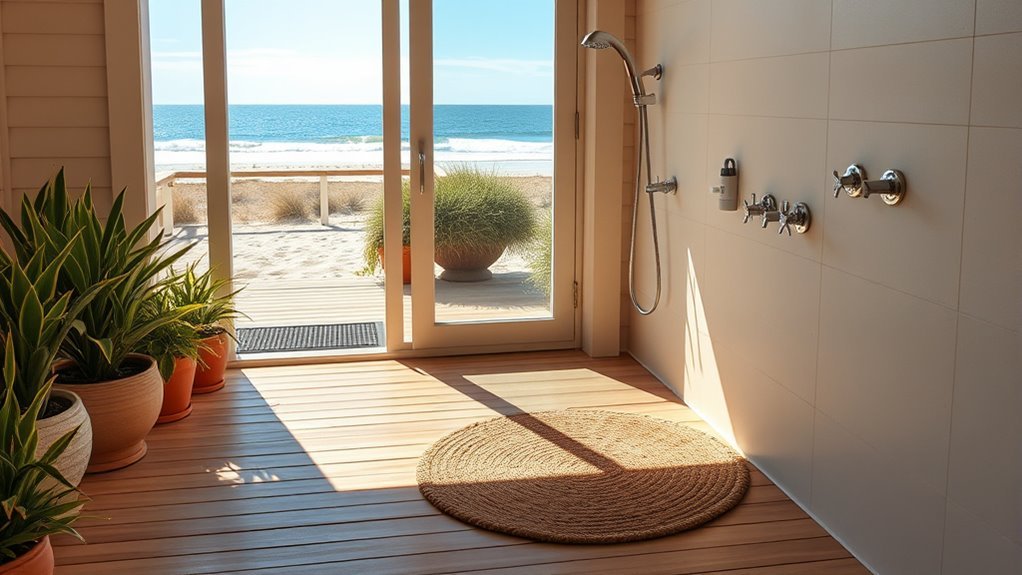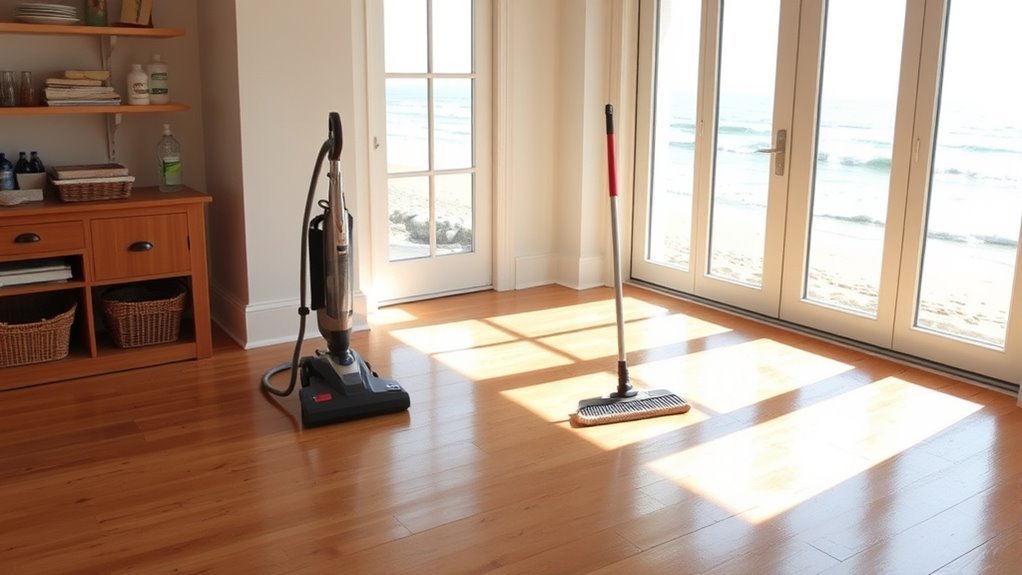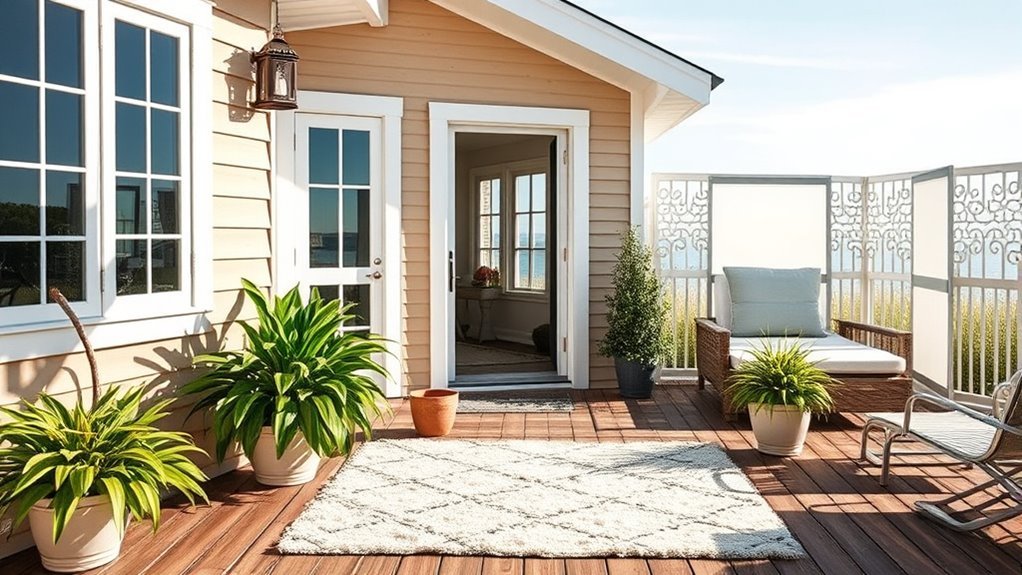How to Keep a Beach House Free of Sand and Salt
To keep your beach house free of sand and salt, start by creating a sand-free entry zone with mats and storage for shoes and gear. Choose durable, salt-resistant furniture like teak or aluminum to avoid corrosion. Stick to regular cleaning routines—daily sweeping and monthly deep cleaning can make a huge difference. Use protective sealants on surfaces and manage outdoor elements like landscaping and furniture covers to minimize salt exposure. Keep going to discover more easy ways to protect your coastal home.
Establish a Sand-Free Entry Zone

Before you track sand throughout your beach house, create a designated entry zone where everyone can remove their shoes and shake off sand. This simple step gives you freedom from constant cleaning and keeps your space feeling fresh. Invest in quality beach entry mats that trap sand effectively and dry quickly. Place them right at the door to catch gritty messes before they spread. Alongside, set up designated storage for shoes, towels, and gear to keep things organized and off your floors. This not only cuts down on clutter but also encourages your family and guests to drop off sandy items immediately. With a well-planned entry zone, you gain control over the chaos sand can bring, letting you enjoy your beach house without feeling tethered to endless cleanup.
Choose Durable and Salt-Resistant Furnishings
Since beach houses face constant exposure to salt air and moisture, you’ll want to choose furnishings that can withstand these conditions without wearing out quickly. Opt for furniture materials like teak, aluminum, or synthetic wicker, which resist corrosion and moisture damage. These durable choices not only last longer but also fit perfectly with coastal decor, giving your space a fresh, breezy vibe. Avoid porous woods or metals that rust easily, as they’ll demand more upkeep and might deteriorate fast. By selecting salt-resistant pieces, you’ll enjoy a carefree, inviting home where you can relax without worrying about wear and tear. This smart approach keeps your beach house looking vibrant and ready for endless days of freedom and fun by the shore.
Implement Regular Cleaning Routines

While beach houses offer a relaxing escape, they also demand consistent upkeep to stay fresh and inviting. You’ll want to implement regular cleaning routines that fit your lifestyle and keep sand and salt at bay. Start by setting clear cleaning schedules to avoid last-minute scrambles. Create routine checklists that cover key areas to maintain order and efficiency. Here’s a simple approach:
- Daily: Shake out rugs and sweep high-traffic zones to prevent sand buildup.
- Weekly: Wipe down surfaces and mop floors using gentle cleaners to combat salt residue.
- Monthly: Deep clean upholstery and vents to maintain air quality and comfort.
Use Protective Treatments on Surfaces
Although regular cleaning helps a lot, protecting your surfaces with specialized treatments is key to preventing damage from salt, moisture, and sand. You’ll want to apply high-quality surface coatings designed specifically for beach environments. These coatings create a barrier that repels moisture and blocks abrasive salt particles, helping your floors, countertops, and outdoor furniture stay pristine. Protective sealants on wood and stone surfaces also guard against corrosion and staining, extending their lifespan. By taking this extra step, you’re not just cleaning—you’re empowering your space to resist the harsh coastal elements so you can enjoy your beach house without constant worry. With these treatments, your home stays fresher longer, giving you the freedom to relax and embrace the coastal lifestyle without hassle.
Manage Outdoor Elements to Minimize Salt Exposure

To keep salt from wreaking havoc on your beach house, you need to actively manage the outdoor elements that carry it inside. Start by embracing salt resistant landscaping; plants like ornamental grasses and succulents can withstand salty air and reduce salt buildup around your home. Next, protect your outdoor furniture with durable outdoor furniture covers to shield them from salt spray and extend their lifespan. Finally, create natural barriers such as hedges or fences that block salty winds and prevent salt particles from drifting indoors. By focusing on these three steps, you’ll maintain a cleaner, fresher living space without sacrificing your freedom to enjoy the beach lifestyle. Managing salt exposure outdoors is the key to preserving your beach house’s beauty and comfort effortlessly.
Frequently Asked Questions
What Are the Best Types of Flooring to Prevent Sand Accumulation?
When choosing flooring to prevent sand buildup, you’ll want durable tile options like porcelain or ceramic—they’re easy to clean and don’t trap grit. Avoid carpet choices that hold onto sand fibers; if you prefer carpet, go for low-pile, tightly woven types that won’t trap as much debris. You deserve flooring that lets you enjoy your space freely without constant cleaning, so pick surfaces that resist sand and salt but still feel comfortable underfoot.
How Can I Protect Electrical Outlets From Salt Corrosion?
Oh sure, why not let salty air wage war on your outlets? But if you want your freedom from constant rewiring, slap on some outlet covers—they’re like little armor for your sockets. Next, get corrosion inhibitors; think of them as peace treaties between metal and salt. You’ll keep your electrical kingdom safe without surrendering to rust. Protect your power, and enjoy your beach life without the shock of surprise outages!
Are There Any Plants That Help Reduce Salt Buildup Around the House?
You’ll love using salt tolerant plants to tackle salt buildup around your home—they’re perfect for coastal gardening. These hardy plants thrive in salty, windy conditions, creating a natural barrier that reduces salt spray reaching your house. Think of species like beach grass, sea lavender, or saltbush; they not only protect your space but give you freedom to enjoy your surroundings without constant maintenance worries. Embrace these plants and let nature do the work for you!
What Ventilation Methods Reduce Moisture and Salt Damage Indoors?
You’ll want to focus on ventilation systems that promote strong airflow while offering humidity control to keep moisture and salt damage at bay. Using energy-efficient exhaust fans and installing a whole-house ventilation system can help circulate fresh air freely, preventing dampness. Dehumidifiers also play a big role in maintaining balanced humidity levels indoors. This way, you can enjoy your space without feeling trapped by the sticky, corrosive coastal air.
How Often Should I Inspect the House for Salt-Related Damage?
Oh, you probably think salt damage signs are just a charming seaside feature to admire, right? Well, if you want to keep your beach house feeling like a haven instead of a salty ruin, you should up your inspection frequency to at least every three months. This way, you catch corrosion or peeling paint early and maintain your freedom from costly repairs. Don’t wait for nature’s salty surprise—stay ahead and enjoy your coastal retreat effortlessly.






